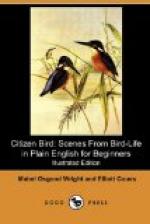“Oh! I know—because he lives in the Rocky Mountains,” said Dodo, clapping her hands at this discovery.
“Yes, that is partly the reason,” resumed the Doctor, after this interruption, “but those mountains are very many, and varied in appearance, like most others: covered in most places with pine trees, but including in their recesses grassy meadows and silvery lakes. Some parts of those mountains are the home of the Rock Wren, but the little fellow is quite as well satisfied anywhere else in the western parts of the United States, if he can find heaps of stones to play hide-and-seek in with his mate, or great smooth boulders to skip up to the top of and sing. So you see the mountains and the Wrens are both named for the rocks.
“Do these Wrens look like our kind and act that way?” asked Nat. “Ours always make me think of mice.”
“All kinds of Wrens are much alike,” answered the Doctor. “They are small brownish birds with cocked up tails, not at all shy about showing themselves off, when they choose, but they must have some hiding-place to duck into the moment anything frightens them, and some odd, out-of-the-way nook or cranny for their big rubbishy nests. Some prefer to hide in marshes among the thickest reeds, some live in dry brush heaps, and some, like the Rock Wren, choose piles of stones. Their wings are not very strong, and they seldom venture far from their favorite retreats, except when they are migrating.
“When your cousin Olive and I were in Colorado we climbed a mountain one day above the timber-line”—
“Do all the trees out there grow in straight lines?” asked Dodo anxiously.
[Illustration: Rock Wren.]
“No, my dear little girl, trees don’t grow in straight lines anywhere,” said the Doctor, laughing—“except when they are planted so. The ‘timber-line’ of a mountain is the edge of the woods, above which no trees grow, and we see nothing but bare rocks, and the few low plants that cling to the cracks among them. Well, we had hardly rested long enough to get our breath after such a climb, when we heard a rich ringing song, something like a House Wren’s, but louder and stronger, and very quick, as if the bird were in a great hurry to get through. But he wasn’t, for he kept saying the same thing over and over again. Presently we spied him, on the tiptop of a pile of stones, standing quite still, with his head thrown back and his bill pointing straight up. He looked gray, dusted over with pepper-and-salt dots on the back, and his bill was very straight and sharp—almost an inch long, it looked. This was a Rock Wren.”
“He must have had a nest somewhere in those rocks,” said Rap. “Wrens most always have nests near where they sing.”
“No doubt he had, as it was the nesting season—June,” answered the Doctor; “but it was growing late in the day, we had a long scramble down the mountain before us, and could not wait to hunt for it. Most likely, too, if we had found the very place where it was, we should not have been able to see it, for probably it was tucked away too far in a crooked passage under a shelving rock.




